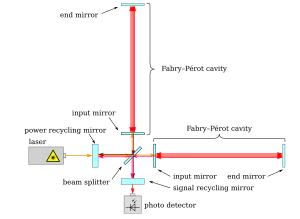LIGO facts for kids
The Laser Interferometer Gravitational-Wave Observatory (LIGO) is a huge science project that looks for tiny ripples in space called gravitational waves. Think of these ripples like waves on a pond, but instead of water, they are waves in the fabric of space and time itself! Scientists at the Caltech and the MIT first thought of, built, and now run LIGO. The National Science Foundation (NSF) helped pay for it.
The NSF also funded improvements to LIGO, making it super sensitive. This allowed scientists to make the very first discovery of gravitational waves! LIGO is the biggest and most exciting project the NSF has ever funded. It helps us learn about some of the most powerful events in the Universe.
Contents
What are Gravitational Waves?
Gravitational waves are like invisible ripples that spread out through space. They are made when really massive objects move very fast. Imagine dropping a heavy stone into a pond; it makes ripples. In space, when huge things like black holes crash into each other, or when giant stars explode, they create these gravitational ripples.
These waves are incredibly tiny by the time they reach Earth. They stretch and squeeze space itself, but only by a microscopic amount. LIGO was built to detect these incredibly small changes.
How Does LIGO Work?
LIGO uses a clever trick with lasers and mirrors to find these tiny ripples. It has two main observatories, one in Hanford, Washington, and another in Livingston, Louisiana. Each observatory has two long arms, each about 4 kilometers (2.5 miles) long, shaped like a giant "L".
Lasers and Mirrors
Inside each arm, there's a super-powerful laser beam that bounces back and forth between mirrors. Normally, the laser light travels the exact same distance down each arm and returns to a detector.
Detecting Space Ripples
When a gravitational wave passes through Earth, it slightly stretches one arm of the "L" while squeezing the other. This tiny change means the laser light in one arm travels a slightly different distance than the light in the other arm. Even though the change is smaller than the width of a human hair, LIGO's special equipment can spot it!
Because gravitational waves are so faint, LIGO needs two separate observatories far apart. If both observatories detect the same ripple at almost the same time, scientists can be sure it's a real gravitational wave from space and not just some local vibration or noise.
Why Are Gravitational Waves Important?
Detecting gravitational waves is a huge step forward in how we study the universe. Before LIGO, we mostly learned about space by looking at light (like from telescopes) or other types of electromagnetic waves.
A New Way to See the Universe
Gravitational waves give us a completely new way to "listen" to the universe. They let us study events that don't give off much light, like when black holes merge. These events are some of the most powerful in the cosmos, and gravitational waves carry direct information about them.
Learning About Extreme Events
By studying these waves, scientists can learn more about:
- How black holes form and grow.
- What happens when neutron stars collide.
- The early moments of the universe.
It's like opening a new window to see parts of the universe we could never see before!
Images for kids
-
Western leg of LIGO interferometer on Hanford Reservation
-
Northern leg (x-arm) of LIGO interferometer on Hanford Reservation
See also
 In Spanish: LIGO para niños
In Spanish: LIGO para niños









